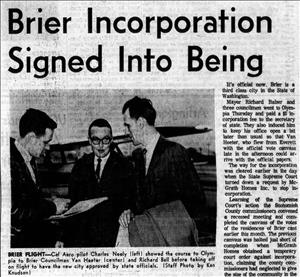On February 11, 1965, the City of Brier (Snohomish County) officially incorporates. The incorporation comes after a brief but intense legal battle seeking to derail the incorporation, followed by a city councilman’s high-speed flight to Olympia to file the incorporation papers with the Secretary of State before his office closes for the day.
Incorporation Blues
Brier is located just north of the Snohomish-King County line, about 15 miles north of Seattle. As the community developed, it had its share of growing pains and dissension over how its growth could best be handled. Things came to a head in 1964 when Thomas McGrath, president of McGrath Homes, tried to annex 35 acres of land that he was developing in the Brier community to Mountlake Terrace immediately to the west so he could more quickly obtain sewer services from the already-established city of Mountlake Terrace.
McGrath’s action prompted Brier residents to take action to incorporate, as they feared Mountlake Terrace would zone the annexed area into smaller lots, leading to a denser population. Residents chose the name Brier from a nearby real estate development with that name. McGrath tried to have his 35 acres deleted from the area to be incorporated, but was not successful. On February 2, 1965, Brier residents voted to approve incorporation by an overwhelming margin of approximately 70 to 30 percent. Voters also elected seven city councilmen, and elected Richard Balser mayor. The incorporation was expected to become official the following week.
But not so fast. On February 4, the Snohomish County election board met to certify the election, but minutes before the board members signed off on the certification, they were served with a restraining order that stopped the process in its tracks. The restraining order, filed by attorneys for McGrath Homes, claimed that the county commissioners had failed to determine the number of residents in the Brier area prior to incorporation as required by law.
On February 10, Snohomish County Superior Court Judge Charles Denney heard the case and refused to issue an injunction stopping the certification. Denney found that the commissioners had acted properly in determining Brier’s population, and the fact that they may not have publicly discussed it before the vote made no difference. McGrath appealed to the Washington State Supreme Court, which rejected his appeal the next day.
Lightning Moves
Lightning-fast action followed. Upon learning that McGrath’s appeal had been denied, the Snohomish County commissioners immediately met to finish the election canvass and to certify the election. At the same time, Mayor Balser and three city councilmen went to Secretary of State Ludlow “Lud” Kramer’s offices in Olympia to be ready to file the incorporation documents, while another Brier councilman, Van Heeter, anxiously waited in the county commissioners’ office for the certification process to be completed so he could personally take the paperwork to Olympia for filing. The tension was electric, as described by the Everett Herald on February 12, 1965:
“Meanwhile Heeter was with the county commissioners fidgiting [sic] and twitching as the clock hands continued to roll and the processes of completing the vote canvass continued to malfunction… [Heeter] finally was able to put all the necessary papers in his portfolio and go racing for his car parked nearby. He was off for the Snohomish County Airport where a plane was standing ready… [but] there had to be an anticlimax, and there was.
“Heeter’s car got stuck in the mud as, a stranger at the airport, he tried to cut across runways to the waiting plane… He wound up on foot. He raised hob with his shine, but he got off for Olympia.”
By then it was so late in the day that Heeter was not able to make it to Olympia before Secretary of State Kramer’s office closed. But the mayor and the three city councilmen already in Kramer’s office were able to cajole him to keep his office open just a bit longer. Heeter made it to Olympia with his papers (and muddy shoes), the incorporation papers were filed, and Brier officially became a third-class city late on the afternoon of February 11, 1965.
Just prior to incorporation, Snohomish County commissioners set Brier's population at 2,168. The 2000 U.S. Census recorded Brier’s population at 6,383; the city’s area is 2.13 square miles.

